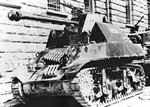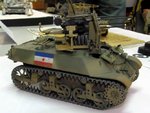Hi to all ¡
The only differences between the PzIV Ausf H and the Ausf J was that the Ausf J carried more fuel and more armour in the turret at the expense of the automatic turning mechanism of the turret (It had to be hand turned, which could be very exhausting), but It didn't changed (as far as I know) the transmission.
Germany was working on a Waffenträger (Geschützwagen Tiger) based on the Tiger IB using a 17 cm gun (probably the KwK already mentioned), called as "Grille 17". It used the 17 cm L50 gun (it only carried 5 pieces of ammo). The only prototype was captured in May of 1945 still unfinished in Haustenbeck (Padderborn); weighing 58 tonnes (It dispensed roof and back armour so It was lighter than the Tiger IB).
If we take the barrel length, It was some 8,70 metres. And we must add the chamber and muzzle brake. Probably it would be more than 9 metres, as Tomo said previously.
Nice true beast .
.
Well, very heavy anti bunker APFSDS shots in limited quantities were ready as early as May or June 1940 (prepared to burst the Maginot and Eben Emael fortresses).
In late 1942 the 28 cm gun was modified as "Glattrohr" (smoothbore barrel) 31 cm gun to fire HEFSDS shells at very large ranges, and in 1944 Germany was playing with medium FlaK gun prototypes firing also HEFSDS shells. Taking in account that in the fights for Silesia in 1944 the 50 mm PaK 39 fired some quantities of uranium cored PzGr 40s, I would guess that If Germany had tried seriously; they would have obtained a smoothbore AT gun of medium size by late 1945.
Also, the only 128 mm FlaK 45 gun built (as prototype, with bigger chamber and extended barrel to 75 calibres) was allocated in firing trials with two barrels; one of them was rifled, and the other smoothbore gun (1500 m/s with APFSDS shots).
From the 37 mm PPS shot. I was said that it made trials in late 1943 and/or early 1944 given the early design of the ring shape sabot.
Hardened steel cored PzGr 40 shots were fired in 1943 and 1944 so it wouldn't have been very crazy providing the shots were impacting at less than 1250 m/s (as It was a limit to prevent the shot break upon impact determined in Germany tests in Meppen and other tests instalations).
Quite true Tomo. Germany tried to make the "Panther" as the only medium tank, but the quantity of T-34 and "shermans" prevented the full switch from Pz IV to the "Panther".
Yes, it always used the KwK/StuK 40 gun, which was in full production (although It never carried the PaK 40 gun as far as I know).
I hope this helps
Early PzIIIs had flimsy 10-speeders. Later models had more robust 6-speeders. Originally, I thought this was just borrowed from the PzIV - but it seems I was wrong: According to Bryan Perret (IIRC ) the PzIV Ausf J had its transmission downgraded to the one from the PzIII - which apparently wasn't able to cope. I think the PzIV J was a waste of time btw.
From what I've heard, Pz-IVJ was simplified version of the Ausf. H, with no issues worth mentioning
The only differences between the PzIV Ausf H and the Ausf J was that the Ausf J carried more fuel and more armour in the turret at the expense of the automatic turning mechanism of the turret (It had to be hand turned, which could be very exhausting), but It didn't changed (as far as I know) the transmission.
The Ferdinand w/ 17cm would've been well balanced weapon, but the weight would've gone too much up.
Length of 17cm barrel was perhaps some 9m (with chamber).
That is long! The weight though could be remedied by removing the appliqué armour (didn't need it?).
Germany was working on a Waffenträger (Geschützwagen Tiger) based on the Tiger IB using a 17 cm gun (probably the KwK already mentioned), called as "Grille 17". It used the 17 cm L50 gun (it only carried 5 pieces of ammo). The only prototype was captured in May of 1945 still unfinished in Haustenbeck (Padderborn); weighing 58 tonnes (It dispensed roof and back armour so It was lighter than the Tiger IB).
If we take the barrel length, It was some 8,70 metres. And we must add the chamber and muzzle brake. Probably it would be more than 9 metres, as Tomo said previously.
Nice true beast
APFSDS was more a thing of 'Panzer 1946' (akin to Luft 46); the captured guns were available, reliable, and plenty.
That's true, but it was trialled in the earlier 37mm (dunno when - hartmann?).
Well, very heavy anti bunker APFSDS shots in limited quantities were ready as early as May or June 1940 (prepared to burst the Maginot and Eben Emael fortresses).
In late 1942 the 28 cm gun was modified as "Glattrohr" (smoothbore barrel) 31 cm gun to fire HEFSDS shells at very large ranges, and in 1944 Germany was playing with medium FlaK gun prototypes firing also HEFSDS shells. Taking in account that in the fights for Silesia in 1944 the 50 mm PaK 39 fired some quantities of uranium cored PzGr 40s, I would guess that If Germany had tried seriously; they would have obtained a smoothbore AT gun of medium size by late 1945.
Also, the only 128 mm FlaK 45 gun built (as prototype, with bigger chamber and extended barrel to 75 calibres) was allocated in firing trials with two barrels; one of them was rifled, and the other smoothbore gun (1500 m/s with APFSDS shots).
From the 37 mm PPS shot. I was said that it made trials in late 1943 and/or early 1944 given the early design of the ring shape sabot.
Steel cores may not have been considered at this time though - being only a desperate measure in '44, or just a crazy idea that wasn't to be taken seriously?
Hardened steel cored PzGr 40 shots were fired in 1943 and 1944 so it wouldn't have been very crazy providing the shots were impacting at less than 1250 m/s (as It was a limit to prevent the shot break upon impact determined in Germany tests in Meppen and other tests instalations).
I'd say that Germans have intended to have Panther as a new medium tank.
Quite true Tomo. Germany tried to make the "Panther" as the only medium tank, but the quantity of T-34 and "shermans" prevented the full switch from Pz IV to the "Panther".
Ah right, good idea. The Hetzer wasn't so good late-war IMO, though still performed well. Was a good ambush weapon. Was even used post-war! Early WW2 though, would've been great (but no gun available?).
Gun was always available
Yes, it always used the KwK/StuK 40 gun, which was in full production (although It never carried the PaK 40 gun as far as I know).
I hope this helps


